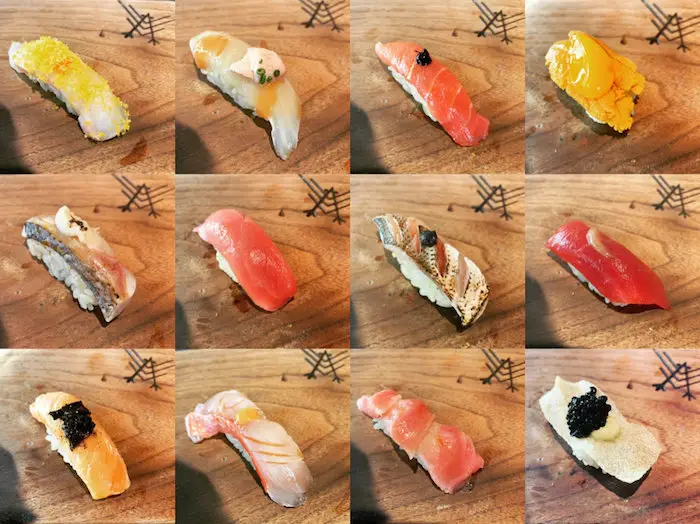We are reader supported. When you purchase through links on our site, we may earn an affiliate commission. Also, as an Amazon affiliate, we earn from qualifying purchases.

If you are new to sushi, you may wonder why raw fish is considered a delicacy while people fret about undercooked beef or chicken meat. Many people find this confusing and avoid eating sushi at all because they are afraid of getting food-borne diseases. Despite this, sushi has spread far and wide and food lovers around the world can’t stop raving about it.
Is sushi safe to eat at all? The answer is ‘yes’ provided that the raw fish or seafood is handled with care and prepared correctly. It has been a staple diet for the Japanese for centuries and millions of people across the globe eat sushi daily without getting sick.
So, why are there so many speculations regarding the safety of sushi? Well, it boils down to the grossest and tiniest of reasons in the form of salmonella, listeria, and tapeworms that can thrive on the raw flesh if not stored properly.
Sushi is often considered as a problematic food because it’s made with raw fish. According to the Food and Drug Administration (FDA), it can be the breeding ground for parasites, bacteria, and viruses. However, that does not mean that you need to worry or avoid it altogether.
The solution lies not in being scared of the unknown but familiarizing yourself with the potential hazards of eating sushi containing raw fish and how to ensure your safety.
Contents
Understanding The Risks Associated With Sushi
Raw fish typically harbors two types of risks – pathogens and contaminants. While they are responsible for foodborne diseases, they can be easily prevented with safe sourcing, correct storage, and hygienic preparation. Let’s talk about them in detail:
Risks Posed By Pathogens
You have probably heard about the risk of pathogens in raw meat such as beef, pork, and chicken. Fish may also contain similar pathogen, although it’s not as toxic as the ones found in land animals. The most common disease caused by harmful pathogens is called anisakis and it can make people sick.
Although fish can be cured of parasites that are visible to the naked human eye, some may be too microscopic to be detected. As a result, they require cooking or deep freezing to get rid of parasites.
The fish found in freshwater are exposed to the risk of tapeworms. However, very few species of freshwater fish are used in making sushi. The chefs mostly use saltwater fish species such as tuna, salmon, shrimp, and mackerel. Unagi is a typical freshwater eel used in sushi and it is always cooked.
As per the Food Standards Agency (FSA), those in the food business must follow the safety standards to serve raw fish. They must source sushi-grade fish from well-maintained farms and store them under suitable temperatures (deep-freezing conditions).
Threats Posed By Contaminants
Another common threat associated with raw meat and fish comes from contaminants like mercury, a naturally occurring toxic metal found in seawater. The mercury level in fish may vary from species to species, however, it’s usually not too high to cause any health issues, except if you are pregnant.
The level of mercury in tuna fish is usually high because this species grows larger compared to other fish, thus stays in the sea for longer. They accumulate mercury over the years and this may pose some substantial health hazards. As a result, people should watch their intake of tuna sushi and restrict it to once or twice per week.
How Is The Threat Minimized By Deep-freezing or Flash-freezing
Deep-freezing is a technique in which fish is rapidly cooled by exposing them to an intensely lower temperature of -30 ° C to -50 ° C, until the flesh is frozen to a temperature of -18 ° C. In this technique, the water content inside the cells is crystallized and this prevents any bacterial growth. Source
As the cells become dormant, the flesh retains its freshness and flavor. The nutritional value of the fish also remains intact in this process. Flash freezing is an advanced technique in which fish is frozen as soon as it is taken out of the sea at ultra-low temperatures (-10 degrees Fahrenheit or less) to turn the flesh solid in a matter of seconds.
According to FDA, fish meant to be consumed raw should be frozen at a temperature of -4 degrees Fahrenheit for at least 7 days or at -31 degrees Fahrenheit for 15 hours. Any raw fish that does not follow this FDA guideline is not sushi-grade, thus not safe for raw consumption. Source
5 Ways To Ensure Your Sushi Is Safe To Eat
The health hazards mentioned above are to educate you about sushi and the risks associated with eating bad sushi. They are by no means meant to discourage you from eating this delicacy. You just need to use your instinct and sense of smell, sight, and touch to make sure you are eating good sushi. Here are five ways to help you stay safe.
#1. Eat Sushi Only At Reputed Restaurants Or Bars
No matter how bad your cravings are, resist the temptation of ding at any sushi outlet without inquiring about its reputation. I strongly suggest everyone to eat sushi only at reputed restaurants that have knowledgeable and well-trained staff.
When the restaurant is popular, you know that there is a huge demand for sushi. Thus, they will always have fresh or sushi-grade fish available. Furthermore, they will never attempt at staining their reputation by serving bad sushi.
The popular sushi joints have experienced chefs who know how to handle raw fish properly to prevent any health risks. As they have a high demand for raw fish, they are in a position to invest in a commercial-grade refrigerator that allows fish to be frozen at -4 degrees Fahrenheit.
If you enter a restaurant and it smells fishy, take it as a red flag which indicates that the establishment does not handle raw fish properly. I would strongly recommend you to avoid eating at such places. You should also avoid the ‘all you can eat’ sushi meals because some restaurants may use this as a way to get rid of their not-so-fresh fish. You must only order AYCE sushi at places that specialize in this format.
#2. Trust Your Senses To Identify Sushi-grade Fish
Not all fish are treated alike and if you are up for a sushi dinner then here are a few things you need to know in order to be safe. As mentioned above, freshwater fish such as brook trout, yellow perch, and pike are not meant to be eaten raw. They must be cooked at a temperature of 145 degrees.
Some of the common fish and seafood varieties that can be safely prepared raw are tuna, sea bass, trout, salmon, mackerel, yellowtail, swordfish, eel, squid, clams, scallop, shrimp, flatfish, crab, and octopus.
Tuna is considered as a popular and comparatively safer option because it swims very fast, hence it can avoid parasites. However, tuna may have high mercury levels due to their big size.
When you order a nigirizushi, sushi roll, or sashimi, use your senses to tell whether the food served on your table contains good or bad fish. Sushi-grade fish has a preserved radiance that makes your nigiri look like a jewel on top of a bed of rice. It will not smell fishy and the fish will melt into your mouth as you eat it.
If the edges around the sashimi piece are discolored or darkened, chances are the fish has gone bad. Also, if your sushi smells fishy or has a strong taste like the sea, the fish used in preparing your dish is certainly not sushi-grade.
Finally, you may do another test using your sense of touch. If you press a finger against fresh or sushi-grade fish, the flesh will immediately bounce back and regain its shape. However, if the fish has gone bad, it will retain an indentation in that area.
#3. Always Buy Quality Fish When Making Sushi At Home
When you are out in the market to buy fish in order to cook sushi at home, make sure you play your cards correctly. One mistake and you can end up causing health problems for you and your family. So, I strictly recommend you to purchase sushi-grade fish from a trusted fishmonger who understands the meaning of sushi grade.
Ask many questions as you like to be doubly sure. Some questions are:
When was the fish caught and where?
Was the fish flash frozen immediately as per FDA standards?
Was it correctly handled during transit?
Are fish supplied to the fishmonger daily?
If you don’t plan to make sushi immediately, transfer the sushi-grade fish to the coldest part of your freezer, once you reach home. Use the fish within 24 hours of buying it because a home freezer is not as powerful as the commercial grade freezers. You will need to thaw the fish completely before using by keeping it inside the refrigerator.
#4. Who Should Avoid Eating Raw Fish Sushi

A section of the population is extremely vulnerable to eating raw fish and these include pregnant women, children, senior citizens, and those with a weak immune system. If you belong to this population, it does not mean you cannot eat sushi.
Contrary to the beliefs, sushi does not mean raw fish and not all types of sushi contain raw meat. In fact, there are numerous sushi variations made of cooked, grilled, smoked, or fried fish. I have created an article that talks about the 15 most popular cooked sushi to order at a restaurant. Check it out!
Pregnant women don’t have to curb their cravings for sushi. They just need to make the right choices and minimize their intake. If you must eat sushi while pregnant, make sure you consume only sushi-grade and limit your tuna intake to once a week.
#5. Minimize Your Raw Fish Consumption
The health risks associated with sushi are specifically not due to ‘sushi’ but the ‘raw fish’ used in sushi (only in cases if the fish is not sushi-grade). You may minimize your raw fish consumption at a restaurant by ordering a mix of raw and cooked sushi.
If you are a beginner, averse to the idea of eating raw fish, you can still enjoy a plethora of vegetable sushi options. Many restaurants serve vegan or vegetable sushi that contains cooked or fresh vegetables such as semi-boiled carrots, tofu, shitake mushrooms, spring onions, sweet potato, bell peppers and so on.
If you are attempting at making sushi at home for the first time and are unsure about where to buy sushi-grade, try a veggie sushi roll instead. Read my article about 30 good ideas to be creative with your sushi rolls, and you will find many vegan options to satisfy your cravings.
5 Common Mistakes To Avoid

If you buy grocery-store sushi, don’t leave it outside or else it may get infected with parasites. Also, don’t store it in the refrigerator for more than 24 hours or beyond the expiry date. When in doubt, just toss it away.
Ordering raw fish that are not familiar, for the sake of adventure. The white tuna is actually a cheaper fish called escolar and it may cause severe diarrhea. Similarly, fugu fish when eaten raw is known to cause food poisoning.
Thawing raw fish by keeping it outside can make it susceptible to bacterial contamination as the edges reach room temperature while the middle part is still frozen. Always thaw frozen fish by leaving it inside the refrigerator overnight.
Buying raw fish from any local fishmonger is a no-no because at times they may sell fish that is actually not flash frozen as per the FDA rules. Always buy from a trusted fish seller or order online from Catalina Offshore Products.
Dining out at restaurants that serve sushi along with other Japanese delicacies. To avoid health risks, always prefer eating at an exclusive sushi-only restaurant or bar.
Related Questions
What are the symptoms of food poisoning caused by eating bad sushi?
If you have mistakenly eaten bad sushi containing bacteria or parasites laden raw fish, you may experience symptoms like watery diarrhea, vomiting, abdominal cramps, nausea, and fever. The symptoms may be severe in people with liver disorders or compromised immune system. Consult a doctor immediately.
See Also: Is Sushi Seafood
What is the benefit of flash freezing raw fish?
Besides preventing bacterial contamination or a parasitic infection, flash freezing also maintains the look and feel of raw fish, without the need for any artificial preservatives. It preserves the nutrition, texture, and flavor of raw fish.
What types of raw fish are safe for pregnant women?
Fish that are low in mercury are considered to be safe for pregnant or breastfeeding women. These include cod, hake, haddock, plaice, flounder, and gurnard. If you are carrying or trying to get pregnant, you should limit your tuna and oily fish (salmon, herring, trout, sardines, mackerel) intake. Eat no more than 2 portions of these fish per week.
Are health risks in sushi only associated with raw fish?
No, health hazards from sushi may also arise from sushi rice gone bad if you let the store bought sushi sit outside for more than 12 hours. If you have leftover sushi rice from dinner, remember to put it inside the refrigerator or else the rice will turn sour and get infected with bacteria. If the sushi rice smells bad, throw it away immediately.

